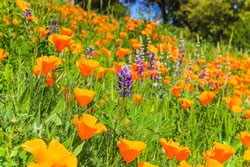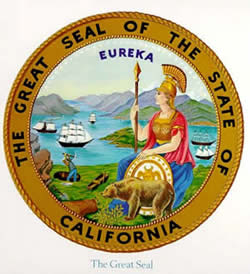California State Symbols
When we first started putting this issue together, we thought it would be simple and easy. But the more we got into it, the more complex it was, but the more fun we had! American states take their symbols seriously and California is no exception.
State symbols are one of the sources of great regional pride. The symbols represent icons that are often unique or outstandingly common within the state. Everyone loves their own “purple mountain majesties” but the symbols might signify the geography, natural history, human history, music, culture or personality of our grand American diversity. Such state symbols are displayed on state seals, flags, postcards, posters and quilts – they serve as emblems of a proud regional citizenry.
Reviewing California’s symbology, it appears that we were initially most impressed with our rich natural resources, both physical and biological—rocks, minerals, plants and animals. However, being the “golden state”, our nationally significant historical mineral made its way into seals, mottos, songs, colors and flags. As time went on, we found ourselves digging deeper (no pun intended) into our human, natural and cultural heritage. We now have forty different California state symbols that reflect our diversity (more than this, since our state tree is two different species, three for our state fish, and we have four state nuts!)
We intended to start the issue by using the California State Library’s excellent listing of our symbols. Soon, this project just got too big, and we decided to scale it down to the region that our college district and the Sierra College Press represents—the Sierra Nevada—that same signature mountain range that defines us on the Pacific Coast of America. This naturally eliminated marine (oceanic) symbols and those found outside of the Sierran geographic province. It also eliminated symbols like the Square Dance (State Folk Dance) and the West Coast Swing (State Dance). The Desert Tortoise (State Reptile) is a fascinating creature, but eschews any habitats other than the warm-to-hot deserts of the southeastern quarter of our state.
 The State Seal is decorated with Sierran representatives, including the mountains themselves and the grizzly bear (Minerva arrived from elsewhere). The motto “Eureka”—or “I found it”—along with our nickname of “the Golden State” certainly refers to the presence of nation-changing gold, which is found primarily in the Sierra Nevada and its foothills.
The State Seal is decorated with Sierran representatives, including the mountains themselves and the grizzly bear (Minerva arrived from elsewhere). The motto “Eureka”—or “I found it”—along with our nickname of “the Golden State” certainly refers to the presence of nation-changing gold, which is found primarily in the Sierra Nevada and its foothills.
While our colors, blue and gold, were the colors of the University of California as far back as 1875, they wouldn’t become our official state colors until 1951. As biologists who love California wildflowers, we like to think Californians picked these colors because every spring we see spectacular blue lupines mixed together with our abundant golden poppies!
California’s pride in the Sierra Nevada, Yosemite National Park and its passionate defender, world-renowned naturalist John Muir dominate our state quarter along with the largest bird of North America, the California Condor. Muir’s legacy in California is monumental and even our State Tartan is based upon the Muir Clan colors as well as the colors of trees, rivers and meadows. Muir, mountains and nature are intricately woven into the collective California ethos.
California is wealthy with superlatives. The tallest, largest and oldest trees live here. The nation’s greatest biological diversity (different native species) exists here as well. This is primarily because we also have the greatest variation in habitats and ecosystems. The tallest peak in the “lower 48” is California’s Mount Whitney at just over 14,500 feet elevation and the lowest spot in the nation (-282 feet) is only 80 air miles away in Death Valley. The list goes on.
Californians often boast of the state’s robust economy (purportedly the 5th largest in the world) along with its agricultural productivity. In 2013, agricultural interests caught the attention of Lt. Governor Gavin Newsom and (while Gov. Jerry Brown was in China) he declared our state fruit (avocado), grain (rice), nut (almond) and vegetable (artichoke), for the year. In July of 2017, students in Merced, California began a campaign to list the almond as the state nut. The idea led to a vibrant exercise in understanding how laws are made as well as bringing forth the significance of four nuts (they’re not actually true nuts) and how important they are to the state’s economy. The results of the exercise assigned almonds, pecans, walnuts and pistachios collectively as the official state nut—a four-way tie! (Each of our “nuts” are actually examples of drupes. True nuts include hazelnuts, chestnuts and acorns).
In 2016 the California legislature also validated denim as our state fabric. This we found odd in that relatively little cotton (proportionately to other states) is grown here and that most “jeans” companies source their cotton from Mexico, China, India and elsewhere. Denim as a fabric certainly plays a role in the history of the Sierra and the California State Library website says that 75% of the designer jeans in the world are fabricated in the golden state! Did they mean designer genes? With that, we’d concur!
So, jump in and read about our fascinating California State Symbols—at least those that exist now (or once did) in the Sierra. While you’re learning more about each symbol, you might come up with something new to suggest to our legislature! A state fungus? A state bacterium? A state domesticated animal? The sky’s the limit! Since we have the nation’s largest state constitution, why not the longest list of state symbols!
—Joe Medeiros and Jennie Skillen, Executive Editors
References
- http://www.library.ca.gov/history/symbols.html
- https://statesymbolsusa.org/states/united-states/california
Photo Credit
- Poppy with Lupine photo, Michele Fodrini
